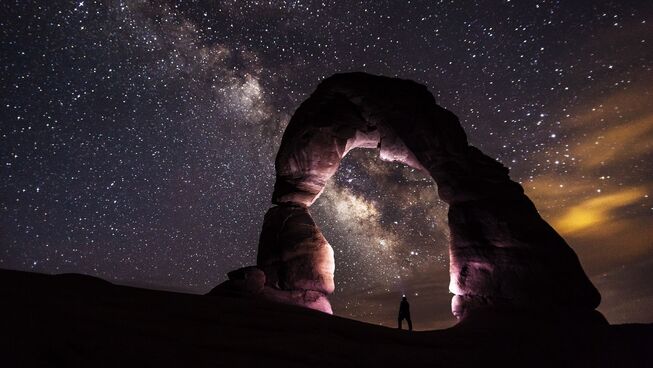Are we alone in the universe?

A guest post by scientist Dr. Michael Smith.
Astronomers have become increasingly successful in identifying exoplanets (that is, planets which are outside our solar system). The first confirmed discovery of an exoplanet was in 1992, and detection rates have accelerated rapidly in the last five years. This year alone, more than 700 have been identified. These planets vary greatly in size, density, composition, and distance from their stars, but we are particularly interested in planets in the so-called Goldilocks zone – that is, not too hot and not too cold, at such a distance from a star that the planet can retain liquid water. Life can exist under a broad range of conditions, but as far as we know it always requires liquid water. The precise location of this zone will vary depending on the size and brightness of the star, the mass of the planet, and the atmospheric pressure on its surface. Only recently has it become possible to detect planets as small as Earth this far away from their stars (such as the recently-discovered planet Kepler-186f). The knowledge that there are other places in the universe that are somewhat similar to Earth has brought a new wave of speculation about what life – if any – might exist on these planets.
While planets in other star systems are exciting, we have no ability to travel to (or even closely observe) any planets outside our own solar system. But we have done a lot of work studying our own planetary neighbours. There are currently two active rovers exploring the surface of Mars, and we have sent dozens of probes to Venus, Mars, and the asteroid belt. We have even sent a few probes to the gas giants in the outer solar system. We have taken pictures, sampled the atmosphere, turned over rocks, drilled ice caps, and analysed soil composition. More than anything else, these missions are hoping to find evidence of alien life.
But what exactly are we looking for?
While we generally think of alien life in science-fiction terms – that is, intelligent complex organisms (usually vaguely humanoid in appearance) – we can be almost certain that such life does not exist in our own solar system. It is far more likely that we would find something resembling bacteria or algae. It is also possible that we could find a “living” organism and not recognise it as such. This is because “life” remains a remarkably tricky thing to define.
Any comprehensive definition of life has to encompass a wide range of organisms, from complex vertebrates to single-celled algae. So biologists tend towards definitions of life which are descriptive: we say that living organisms exhibit most or all of the following traits:
- Organization (the organism is structurally complex, composed of one or more cells, which are regarded as the basic unit of life)
- Metabolism (transformation of energy)
- Growth
- Response to stimuli
- Reproduction
- Homeostasis (regulation of the internal environment)
There is also another vital feature of living organisms: they contain enormous quantities of information, encoded in organic molecules. All of the growth, metabolism, reproduction, and stimuli response requires blueprints and instruction sets. Complex, information-bearing carbon chains are a universal feature of every living organism. (This concept of the information content of life also has important implications for the origin of life, but we will get to that a bit later).
What would extra-terrestrial life look like?
So now that we’ve considered what constitutes life, what might we hope to find? Well, any life that exists in our own solar system is most likely to resemble a group of terrestrial organisms that we call “extremophiles”. These live at the very limits of what we can call a “habitable zone”: they include the alga Thermus aquaticus, which thrives at up to 80°C, and bacteria such as Verrucomicrobia, which uses methane as an energy source, and Deinococcus radiodurans, which can survive under high radiation levels. By studying these organisms, we can better understand the limits of what life can tolerate.
Of course, when life first started on Earth, our own planet was a pretty extreme place. Scientific consensus is that the Earth is about 4.5 billion years old, and for the first 500 million years (the Hadean Eon) it had a partially molten surface and endured high levels of volcanism. Surface temperatures reached over 200°C, and the atmosphere had high concentrations of CO2. And yet, in this inhospitable environment, life seems to have emerged quite rapidly. The oldest dated rocks are 3.8 billion years old, and the oldest fossil evidence for life is about 3.7 billion years old. Fossils of microbial mats (very similar to still-living stromatolites) can be found in 3.6 billion-year-old rocks in Western Australia.
How does life get started, anyway?
Until fairly recently, the origin of life on Earth wasn’t really a big mystery, since it was assumed that living organisms quite regularly arose “from nothing”. This idea of spontaneous generation dates back at least to Aristotle: in the philosophy of the ancient Greeks, bees were generated from flowers, and aphids from the dew which falls on plants. This idea went unchallenged until the mid-19th century, since it fits observations so well on a macroscopic level. Mould will indeed spring to life “from nothing” in the presence of a suitable substrate, and algae will “spontaneously” form in water over time. But in the 1860s, Louis Pasteur demonstrated that all of this apparently spontaneous generation relied on the presence of living microbes. He developed the germ theory of disease, and along the way, brought a new challenge to the biological sciences. If the emergence of life requires pre-existing living organisms, where did the first life on Earth come from?
It seemed inconceivable that living organisms could be formed from inorganic material, so science looked further afield for the source of life on Earth. The prevailing scientific consensus in the late 19th century was that the universe was eternal and steady-state, and so it was suggested that life was simply an eternal in-built feature of the universe. This led to the panspermia hypothesis, which proposes that life was “seeded” on the primeval Earth from outside sources (for instance, though a meteorite impact). But in the late 1920s, a Belgian priest named Georges Lemaître developed what is now known as the Big Bang theory, which did away with the “eternal universe”. So the panspermia hypothesis doesn’t really help us with the question of life’s ultimate origin.
This is how we wind up with the most common hypothesis today, which is abiogenesis on the ancient Earth. However, there still isn’t a widely-agreed upon idea of how exactly we can get living organisms from inorganic material. The Miller-Urey experiments (1953) seemed to offer hope: if you take water, methane, ammonia, and hydrogen and fire a spark through it, you can create amino acids. And there have been similar experiments and hypotheses over the past 50 years, all with the general goal of creating complex molecules from chemicals that may have been present on the early Earth. (The composition of the early atmosphere is far from agreed upon, so it’s uncertain how realistic these experiments are). But there is a huge gulf between generating simple amino acids and generating proteins or complex carbon chains. And there is a still bigger gulf between amino acids and a cellular structure capable of controlled replication.
Perhaps the biggest gulf of all is the one between random molecules and complex information-bearing genomes. The challenge of combining amino acids into any long random chain is hard enough, but all of life as we know it depends on the creation of extremely specific chains, which carry enormous informational content. The origin of this information is truly mysterious. The science of information theory is still in its infancy, but it appears that information cannot arise spontaneously, and cannot (as far as we know) result from a random mechanical process. Information is only created by an intelligent mind.
Francis Collins, former head of the Human Genome Project, had this to say:
“How did self-replicating organisms arise in the first place? It is fair to say that at the present time we simply do not know. No current hypothesis comes close to explaining how in the space of a mere 150 million years, the prebiotic environment that existed on planet earth gave rise to life. That is not to say that reasonable hypotheses have not been put forward, but their statistical probability of accounting for the development of life still seems remote.”
With most of biology the standard answer to seemingly impossible questions is “random mutation plus natural selection plus time”. But it’s important to stress that abiogenesis is entirely unrelated to the theory of evolution. Evolution deals with inheritable modifications over time in existing living organisms, and has nothing to say about how that chain of inheritance may have started. Nevertheless, the interconnectedness of all organisms through the tree of life tells us that, even on Earth, life seems to have only started once. So even on this (apparently) most habitable of planets creating life might not be nearly so easy.
So how does extra-terrestrial life affect my faith in God?
The Bible is silent on the question of life elsewhere in the universe, but I would have no problem accepting that God decided to make life on other planets. “The heavens declare the glory of God; the skies proclaim the work of his hands.” (Ps. 19:1), and that includes any possible other life forms. There are fascinating hypothetical questions to consider, such as: is the human redemption story is applicable to intelligent alien life? would they have the capacity to acknowledge the sovereignty of God?, but the answers to these questions is unknowable at this stage.
But there is another question beneath the surface of the search for alien life: would finding life elsewhere in the universe make life on Earth – and particularly human life – less special?
I don’t think it would. Scripture does not say that we are the only intelligent life in the universe, but it does say that humans are uniquely special. Firstly, because we are imbued with the image of God, and secondly because God himself became human in the person of Jesus. The letter to the Hebrews tells us that the same Jesus, fully God and fully human, remains our intercessor and saviour (Heb. 7:24-25). This makes humans distinct from other living things, on this or any other planet.
Michael has a PhD in zoology from the University of Melbourne. This piece was written with the assistance of his wife Christina, who holds a PhD in astrophysics. Michael also writes the blog Spiritual Meanderings.
Image courtesy of Victor Habbick / FreeDigitalPhotos.net





